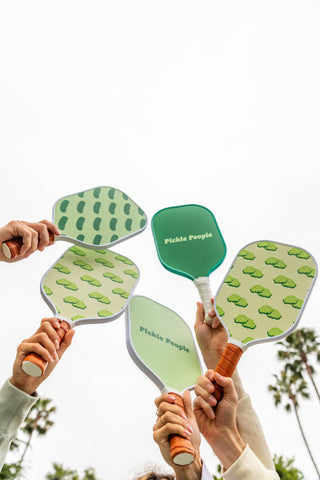Let’s be honest: learning pickleball rules can feel like someone handed you a mystery novel with the last chapter ripped out. To make your life more simple, here’s a beginner-friendly guide to how the game actually works.
How to Play Pickleball
Pickleball is a paddle sport played with a plastic ball, either in singles (one-on-one) or doubles (two-on-two). Doubles is the most common format—and arguably the most fun.
Each rally begins with an underhand serve, hit diagonally across the court. Only the serving team can score points. Once the ball is in play, both teams try to keep the rally going by hitting the ball back and forth over the net—until someone makes a mistake. A rally ends when a team hits the ball out of bounds, fails to return it, hits into the net, or commits a fault like stepping into the kitchen (the non-volley zone) at the wrong time.
Games are typically played to 11 points, but you must win by at least 2 points. That means a game can continue past 11 if the score is close, like 11–10 or 12–11.
The Two-Bounce Rule
This is the rule that tends to trip people up early on. When the ball is served, the receiving team must let it bounce once before returning it. Then, the serving team must also let it bounce once before hitting it back. Only after those two bounces is the rally truly in motion. From that point on, you can either volley (hit the ball out of the air) or let it bounce before returning—just watch your footing in the kitchen.
The Kitchen (No-Volley Zone)
The kitchen is a seven-foot zone on either side of the net where volleying is not allowed. If you're standing in the kitchen—or even touching the kitchen line—you can’t hit the ball out of the air. But you can enter the kitchen to play a drop shot, dink, or make a soft return off a bounce. Think of the kitchen as a quiet zone: soft, strategic shots are welcome, but no loud smashes or big overheads allowed.
Serving: Keep It Simple
Serves in pickleball must be underhand and hit diagonally across the court. The ball has to land beyond the kitchen—short serves don’t count. Each player gets only one serve attempt, unless the serve clips the net and still lands in (called a “let”), in which case you replay it. In doubles, each team gets two chances to serve per rotation—one per player. Once both players have lost their serve, the ball goes to the other team.
Scoring
Pickleball scoring has its own rhythm. The score is announced as three numbers: your team’s score, your opponent’s score, and the server number (either 1 or 2). So if someone calls out “3-2-1,” that means your team has 3 points, your opponents have 2, and you're the first server on your team. It sounds more complicated than it is. Honestly, if you're not sure, just turn to your partner and ask, “Am I up?”
What’s In and What’s Out?
If the ball lands on the line, it’s in, line shots count. If the ball hits the net on a volley and makes it over, keep playing. But if it hits the net and stays on your side, the rally’s over and the point is lost.
Final Dink
Pickleball rules might seem quirky at first, but they’re easier than you think. Just remember this: keep it bouncing when you should, respect the kitchen, and serve underhand like you mean it.
Want to level up faster? Find a partner who knows the ropes, and don’t forget the snacks. Good games (and good vibes) start there.






